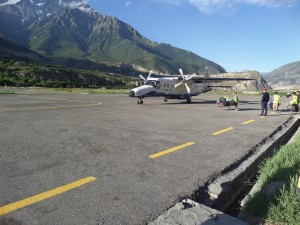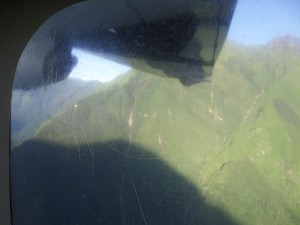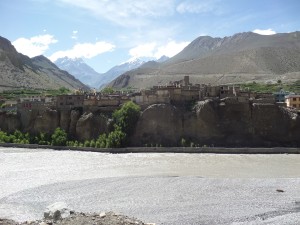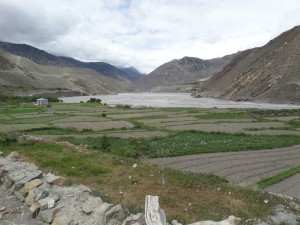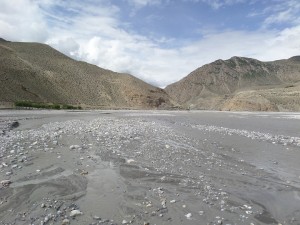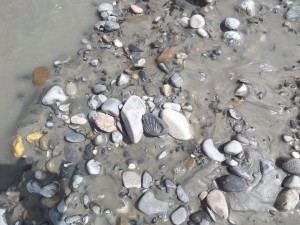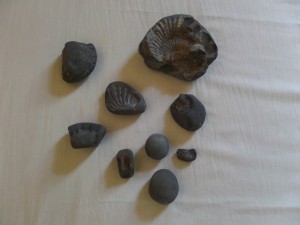While the veneration and ritual life of Shaligram Stones outside of Mustang District is its own complicated matter of course, the actual experience of searching for and finding Shaligrams in the Kali-Gandaki River certainly cannot be omitted from any account of their meaning and use.
As I set out this morning, clad in my canvas field pants and a pair of Vibram KSOs (extremely well-suited to walking around in fast-moving, shin-deep, river water), I found myself a little sad that this would be my last day Shaligram hunting on the outskirts of Kagbeni. The Kali-Gandaki river bed is nearly a mile wide in most places around the village, and as the river slowly meanders back and forth across the valley from bank to bank, it reveals a new landscape of stones and silt each morning. The trick to finding Shaligrams, as I have found, is to find one of many small, shallow, side-streams (particularly ones that are clearly in the process of moving off course or have recently petered out in favor of rejoining the main river current) and walk along them slowly up-river with a sharp eye towards any recently exposed areas.
In this way, as one picks their way along through sun-warmed, crystal-clear waters, Shaligrams are slowly revealed to the discerning eye. In Hindu practice, the most important aspect of ritual veneration when it comes to both Shaligram Stones and to other murti (sacred images and statues of Hindu deities used in worship) is the darshan, a Sanskrit word meaning “to see.” But this aspect of “seeing” doesn’t just mean to see the deity physically, as one would when entering a temple (mandir) or shrine, it means to behold the deity as he or she truly is beyond the material obvious to the eye and in return, to be beheld by the deity yourself as well. This practice of seeing and being seen by the deity is thus one of the most common, and most important, parts of ritual practice among observant Hindus and is, also, one of the major driving forces behind pilgrimage throughout South Asia.
Searching for Shaligrams is its own kind of darshan. As I walked with particular care not to disturb too much sediment in the water, I noticed two especially important things about the experience I was undertaking. Firstly, the dark, almost inky, black color of a Shaligram Stone was the first thing that tended to catch the seeker’s eye (since it easily stood out against a plethora of grey and brown), the second was the subtle appearance of ripples or spirals (the tell-tale ridges of the fossil ammonite shell) along its surface that indicated that the stone in question might, in fact, truly be Shaligram. But not every stone that might initially appear this way was really Shaligram. In many cases, the refraction of light through the flowing water often gave the impression of such patterns on otherwise smooth stones and the accumulation of silt underneath the current was also often responsible for the appearance of similar looking patterns in the sand that covered the river bed. More often than not, a burst of excitement and a quick scoop of water to retrieve a sacred stone appearing in the river might end up with nothing more than a handful of sand and a plain rock.
For this reason, actually finding a Shaligram Stone often left me with the sense of something truly born from the river, something only appearing at the very moment that I happened to see it. Carried down through millennia of time (or more like 175 million years if we’re going by the discourse of science) by an ancient and sacred tirtha to be revealed just at that moment and just for me. Something that I was “seeing,” perhaps, that hadn’t been there a moment before. (Tirtha is a Sanskrit term meaning “bridge,” often referring to places where the divine world and the physical world are closer together. In this case, I’m referring to the Kali-Gandaki. Most sacred rivers in South Asia are considered tirtha)
Experiencing the discovery of a Shaligram Stone leaves one with significant food for thought. Not only are Shaligram Stones considered direct manifestations of God-Himself (unmade by the hands of men) but I would argue that it isn’t just their aniconic (non-human) shape or their natural formation that grants them such a reverent status beyond the ubiquitous murti of temples and roadside shrines; it’s the experience of seeking and finding them in the first place that bestows a sense that these objects come from some other place beyond the industry and understanding of human-kind. It is no wonder that so many travel so far just for the chance of being granted the smallest glimpse of something truly beyond. Whether fossil or deity, the Shaligram comes to us from a place none could ever truly fathom.

The play of light and water that makes a smooth, river, stone look like Shaligram.

Here you can see the ripples that often deceive Shaligram seekers.
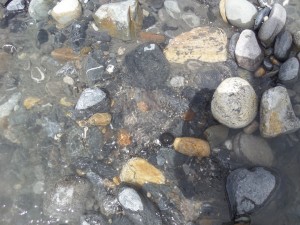
A Shaligram is Revealed! You can see the round, black, Shaligram near the center of the photo.
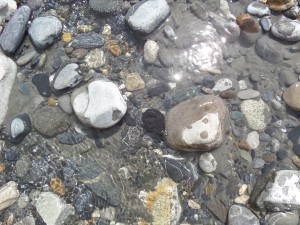
And finally, a Sudarshan Shaligram, with clear chakra markings, appears in the river!

